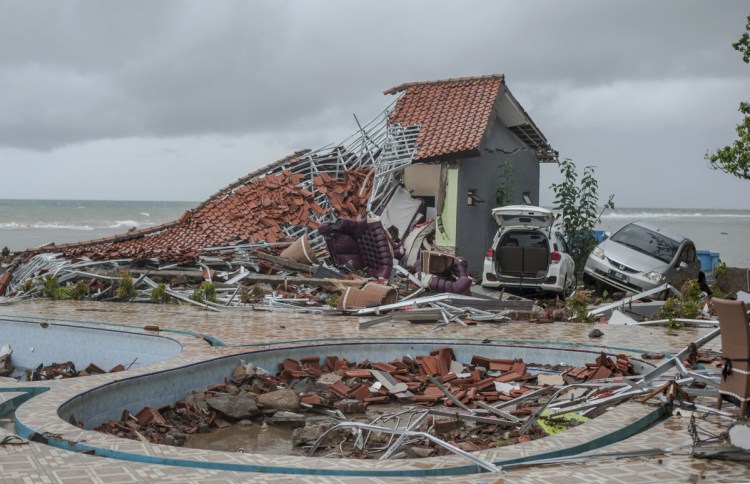JAKARTA, Indonesia — No one paid much notice when the Anak Krakatau volcano stirred.
It has been rumbling for months, spewing columns of superheated ash and ribbons of lava that hiss into the currents between Indonesia’s most populated islands.
Beach parties were in full swing under a full moon. Vacationers were having a late meal at seaside restaurants on the western tip of Java Island.
Then – a little over 20 minutes after Anak Krakatau’s latest eruption – the sea rose up without warning, possibly triggered by an undersea landslide shaken loose by the volcanic activity. A three-foot tsunami surge roared ashore, sweeping up everything in its path: boats, tables, people.
A tragic year for Indonesia added more deaths and misery. At least 280 people were counted among the dead Sunday – with authorities predicting the numbers could rise as disaster teams fanned out in villages and coves along the Sunda Strait, about 60 miles from Jakarta
Indonesia’s Disaster Management Agency, which announced the death toll, also said nearly 850 people were injured by the tsunami that struck late Saturday with deadly stealth from the waters between Java and Sumatra.
Indonesian authorities are always on alert for tsunamis after any seismic activity in one of the world’s most quake-prone regions. But this one caught everyone off guard.
No tsunami alerts was raised, and there was no big temblor to even get the warning system in motion.
The initial speculation by experts, including Indonesia’s Meteorology and Geophysics agency, was that an undersea landslide pushed the wall of coffee-colored water that raced toward the shore.
Sutopo Purwo Nugroho, spokesman for Indonesia’s disaster agency, said the preliminary theory was that the tsunami was caused by “an undersea landslide resulting from volcanic activity on Anak Krakatau.” An unusually high tide because of the full moon compounded the surge, he said.
“Data collection is still ongoing. It’s likely that the number of victims and damages will rise,” Nugroho said.
David Applegate, associate director for natural hazards at the U.S. Geological Survey, said in a telephone interview Sunday that the tsunami was unusual because it was not among the 90 percent caused by an earthquake. It was most likely caused by volcanic activity that led to a submarine landslide and thus came by surprise, he said.
“This is probably the ultimate no-notice event,” he said.
While it is clear that there wasn’t a large earthquake triggering the tsunami, a definitive cause is not yet known but will likely be determined in the next day or so, Applegate said.
“The only question is whether it is related to volcanic activity,” he said.
The tsunami hit with such surprise that the drummer of a local rock band, Seventeen, was getting the riff going for a song just seconds before the water slammed into the back of the stage at a beach concert. The platform buckled. The band members and their equipment pitched forward as the water swept into the crowd.
At least four members of the band were killed, the Reuters news agency reported. One crew member, identified by Channel News Asia only by the first name Zack, said he survived by holding on to part of the collapsed stage.
“Underwater, I could only pray ‘Jesus Christ, help!'” Zack said of his struggle in the water. “In the final seconds, I almost ran out of breath.”
The waters ripped houses from their foundations, left cars and boats smashed against palm trees. Thatched bamboo shacks were torn apart. Before daybreak, disaster crews were gathering the dead and creating outdoor morgues piled with orange body bags – scenes that have been repeated many times this year in Indonesia.
Copy the Story LinkSend questions/comments to the editors.



Success. Please wait for the page to reload. If the page does not reload within 5 seconds, please refresh the page.
Enter your email and password to access comments.
Hi, to comment on stories you must . This profile is in addition to your subscription and website login.
Already have a commenting profile? .
Invalid username/password.
Please check your email to confirm and complete your registration.
Only subscribers are eligible to post comments. Please subscribe or login first for digital access. Here’s why.
Use the form below to reset your password. When you've submitted your account email, we will send an email with a reset code.